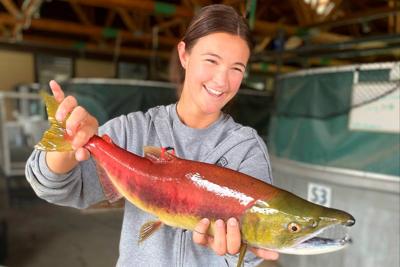forum
library
tutorial
contact

First Sockeye of 2021
Finally Arrives to Redfish Lake
by Jerry Painter
Post Register, August 10, 2021
|
the film forum library tutorial contact |

|
First Sockeye of 2021
by Jerry Painter
|
 With all the usual roadblocks and this year's added concerns of dangerously high temperatures and low water levels, Idaho Fish and Game was worried no sockeye salmon would return from the ocean without some help.
With all the usual roadblocks and this year's added concerns of dangerously high temperatures and low water levels, Idaho Fish and Game was worried no sockeye salmon would return from the ocean without some help.
But the state celebrated last week this year's first sockeye salmon return a few weeks behind schedule.
"We had a lot of concern whether we were going to get any fish back at all," Roger Phillips, Fish and Game's information supervisor. "This is a year we were very happy to write that press release that the first sockeye had made it back."
Each year, Fish and Game follows closely the migration of the endangered salmon that is essentially on biological life support after declining from an estimated 30,000 to only a handful in recent decades. Sockeye normally start showing up at Redfish Lake the third week in July and continue returning into late September and early October.
Phillips said the lone sockeye was trapped Aug. 7 at the outlet of Redfish Lake after returning 900 miles from the Pacific Ocean.
Poor migration conditions this year prompted Fish and Game to make an end-run on the migration and trap 201 sockeye at the Lower Granite Dam -- the last dam on the migration journey up the Snake River -- then transport them to the Eagle Fish Hatchery. Biologists were worried that low water levels and high temperatures in the Snake and Salmon rivers would prevent the fish from arriving at their spawning waters in the Sawtooth Basin of central Idaho.
Phillips said 617 fish had made it to Lower Granite Dam through last week.
"The way that trap works (at Lower Granite Dam) we couldn't physically be in there trapping 24/7 during that period," he said. "There was a federal permit for us to take those fish. It would only allow us to take 250 or something like that at that time. We were only taking some of those fish and others were passing through."
Biologists wanted at least a few hundred to ensure enough spawners for next year's migration.
In July, some of the waters in the Salmon River were reaching 75 degrees; deadly to cold-water fish.
"That sent up a lot of red flags when that was still fairly early in the run," Phillips said. "We didn't know what kind of conditions were going to hit after they crossed the Lower Granite. That was going to be our last chance to trap them."
Having a fish arrive on its own steam means the amazing animal somehow figured a way through the migration gauntlet.
"While this is good news that a sockeye has made the full migration to the Sawtooth Valley basin, we still expect the percentage of fish able to make that trip this year will be well below the average conversion rate of approximately 51 percent," John Powell, Fish and Game fisheries research Biologist. "This reduced migratory survival is why we decided to trap fish at Lower Granite Dam and haul them to Eagle Fish Hatchery, where those fish and natural returners will be safely held until it's time to spawn in the fall."
Fish and Game reported that this year's sockeye return will likely be below past returns.
The Lower Granite Dam return so far is below the 10-year average of 800 sockeye, and slightly below last year's total of 640 at Lower Granite. Of those, 151 sockeye made it back to the Sawtooth Basin last year.
Sockeye returns to the Sawtooth Basin have fluctuated wildly over the last decade from a low 17 in 2019 to a high of 1,579 in 2014 and a 10-year average of 437.
"We like to see fish in the thousands rather than the hundreds, but certainly hundreds is a lot better than in the dozens or even single digits," Phillips said. "We're always trying to wait for those planets to align where we have a good out-migration, and good reverse migration and get a nice run back. It can happen, but you sit back and cross your fingers."
Related Pages:
Count the Fish, 1977-2014, Salmon Recovery Efforts by GAO
A Truck-assisted Migration: Salmon Smolts Get a Helping Hand to Reach Coast Amid Severe Drought by Harry Morse, Idaho State Journal, 6/16/21
'This is Worse' than 2015: Northwest Weather Heats Rivers, Puts Idaho Sockeye in Danger by Rocky Barker, Big Country News, 7/4/21
Sockeye to be Trucked to Redfish Lake by Associated Press, Challis Messenger, 7/8/21
learn more on topics covered in the film
see the video
read the script
learn the songs
discussion forum
